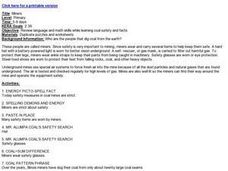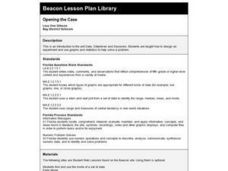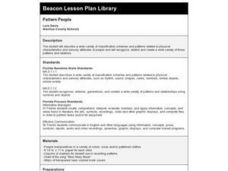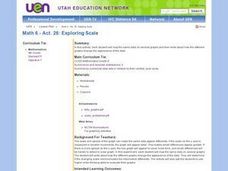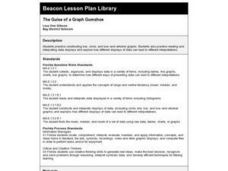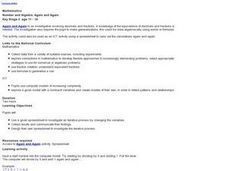Curated OER
Enigmas
Students research various "mysterious" elements of literature, math, science, technology and life itself.
Curated OER
and and Ocean Views of Earth by Remote Sensing
Students explain how satellites help scientists to see more than with the unaided eye and how Landsat technology works. Students identify vegetation and fire sites in the rainforest and detect erosion along rivers. They are able to use...
Curated OER
Miners
Students complete various activities related to mining and mining safety. They write an energy sentence, complete a word puzzle, cut and glue safety equipment on a mining character, solve a math code word puzzle, and complete a maze...
Curated OER
Opening the Case
Students participate in a class survey and then design an experiment and use graphs and statistics to assist them in solving a problem. They organize the results of the survey in a stem-and-leaf plot and find the range, median, mean, and...
Curated OER
Closing the Case
Fifth graders collect data and prepare data displays using a survey with statistical information.
Curated OER
Using Statistics to Uncover More Evidence
Fifth graders participate in an online Web lesson plan on ways of interpreting data. They conduct a survey and interpret the results in a journal entry.
Curated OER
What Shape Is It?
Students attempt to determine the shape of a hidden item by bouncing a ball off of it. They attempt to determine how a ball would bounce off of an item and by rolling the ball until it hits and bounces off the item. They draw both their...
Curated OER
The Case of the Mysterious Red Light
Students investigate why some sunrises and sunsets are unusually bright red.
Curated OER
Pattern People
Students describe a wide variety of classification schemes and patterns related to physical characteristics and sensory attributes of people. They recognize, extend and create a wide variety of those patterns and relations.
Curated OER
Classroom Triangles
Students use bearing measurements to triangulate and determine objects' locations. Working in teams of two or three, students must put on their investigative hats as they take bearing measurements to specified landmarks in their...
Curated OER
Slides, Flips and Turns
Third graders are introduced to different types of transformations. As a class, they describe how a stuffed animal slides across the floor and use themselves to demonstrate as well. Individually, they flip and turn in different...
Curated OER
Exploring Scale
Sixth graders discuss how the scale and type of graph can change how the data appears. With a partner, they identify all the information about the graph in a specific amount of time and record them in a journal. To end the lesson, they...
Curated OER
Average Looking
Young scholars use measurements of their classmates to find the average (means and modes) of their facial features. They use their findings to create a three-dimensional "class head." Examples and assessment materials are included.
Curated OER
Finding the Flu
Young scholars work to determine when the flu is most prevalent in the United States. They gather data on their own, create calendar, charts, and graphs, analyze their findings and present them. This is a very appropriate winter lesson!
Curated OER
Statistical Specimens
Third graders are introduced to statistical vocabulary. They complete an online activity that asks them to calculate the mean, median and mode for a set of data.
Curated OER
The Guise of a Graph Gumshoe
Eighth graders practice constructing bar, circle, and box-and-whisker graphs. They practice reading and interpreting data displays and explore how different displays of data can lead to different interpretations.
Curated OER
Raising the Bar While Hogging the Ham (Radio That Is)
Students create a bar graph that communicates an amount without the need to know the exact data, determine what scale to use to best represent the data and use their bar graph to persuade others.
Curated OER
What is the Relationship Between Radioactivity and Radon?
Students examine the relationship between radioactivity and radon. They practice using a geiger counter with different materials. They answer questions to complete the lesson.
Curated OER
How Does Probability Relate to Radon?
Middle schoolers read an article about probability and radon. They practice using a hand held geiger counter to understand the properties of radiation and radioactivity. They identify the harmful and helpful effects of radiation as well.
Curated OER
Number and Algebra: Again and Again
Students use a given spreadsheet to investigate an iterative process by changing the variables. They design their own spreadsheet to investigate the iterative process.
Curated OER
The Air We Breathe
Students discover the cuases of pollution. They investigate different pollutants that exist. Stsudents research technologies developed by engineers to reduce the amounts of air pollution. Upon completion of assigned activities,...
Curated OER
Slope Calculation
Students practice calculating the slope of a line. They explain how the formula is derived and identify properties that are associated with positive, negative and undefined slopes. They complete an online activity as well.
Curated OER
The Numbers Game
Students examine how to calculate the part-per-million and part-per-billion units used to measure contaminant concentrations in the environment. They calculate ratios, take a quiz, analyze a sample chemical spill, and determine if...
Teach Engineering
Don't Be a Square
If Parseltongue is a genetic trait, what is the probability a wizard will inherit the ability to speak Parseltongue? Scholars investigate magical and biological genetics with Punnett squares.




